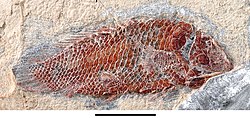Biology:Serenoichthys
| Serenoichthys | |
|---|---|

| |
| Fossil specimen (scale bar 1 cm) | |
| Scientific classification Error creating thumbnail: Unable to save thumbnail to destination
| |
| Domain: | Eukaryota |
| Kingdom: | Animalia |
| Phylum: | Chordata |
| Class: | Actinopterygii |
| Order: | Polypteriformes |
| Family: | Polypteridae |
| Genus: | †Serenoichthys D. B. Dutheil, 1999[1] |
| Species: | †S. kemkemensis
|
| Binomial name | |
| †Serenoichthys kemkemensis D. B. Dutheil, 1999[1]
| |
Serenoichthys is an extinct genus of small bichir from the Late Cretaceous (Cenomanian) of southeastern Morocco.[1] The genus is monotypic, the type and only species being Serenoichthys kemkemensis.[2] Only known at first from postcranial skeletons, complete specimens were later discovered.[3]
Etymology
The generic name Serenoichthys (Sereno's fish) was given after the leader of the team responsible for the discovery, Paul C. Sereno. The species name, kemkemensis, refers to the Kem Kem locality in Morocco where the fossils were discovered.[1]
Description
Serenoichthys was comparatively small, with the fossils discovered reaching at most 5 cm (2.0 in) in length — in comparaison, the contemporary polypterid Bawitius could reach up to 300 cm (9.8 ft).[3] Its body was relatively short and tall compared to modern polypterids, closer to the original actinopterygian body plan.[1]
Like modern-day polypterids, Serenoichthys possessed a dorsal fin divided into a series of independent finlets each supported by a spine, a defining synapomorphy of the Cladistia.[1]
References
- ↑ 1.0 1.1 1.2 1.3 1.4 1.5 Dutheil, Didier (June 1999). "The first articulated fossil cladistian: Serenoichthys Kemkemensis, gen. et sp. nov., from the Cretaceous of Morocco". Journal of Vertebrate Paleontology 19 (2): 243–246. doi:10.1080/02724634.1999.10011138. Bibcode: 1999JVPal..19..243D. https://www.researchgate.net/publication/244484839. Retrieved 18 September 2022.
- ↑ "Fossilworks: Serenoichthys". http://www.fossilworks.org/cgi-bin/bridge.pl?a=taxonInfo&taxon_no=255188.
- ↑ 3.0 3.1 Ibrahim, Nizar; Paul C., Sereno (21 April 2020). "Geology and paleontology of the Upper Cretaceous Kem Kem Group of eastern Morocco". ZooKeys (928): 73–75. doi:10.3897/zookeys.928.47517. PMID 32362741. PMC 7188693. https://zookeys.pensoft.net/article/47517/. Retrieved 18 September 2022.
Wikidata ☰ Q21217650 entry
 |

